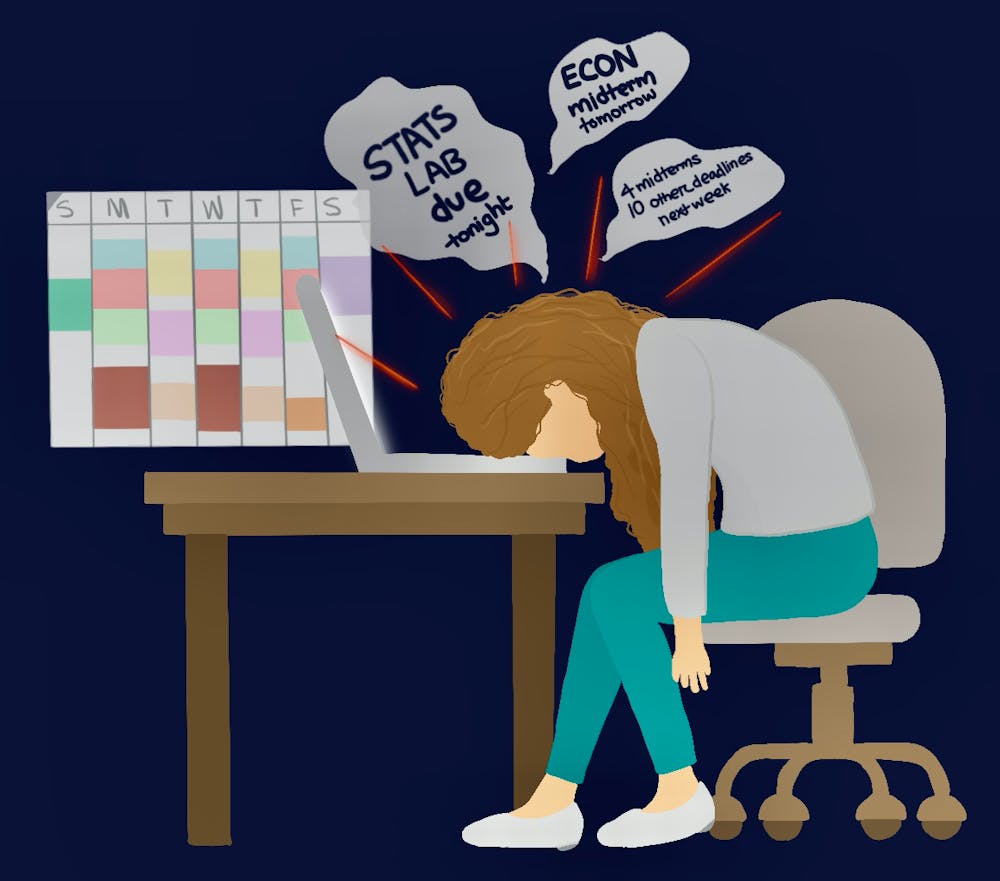In October 2020, the University announced that the structure of spring 2021 would look notably different than in years past. Instead of a week-long spring break during early March, there were going to be four break days interspersed throughout the semester, with each break day falling on a different day of the week — Wednesday Feb. 17, Tuesday March 9, Monday March 29 and Thursday April 15. With finals approaching and the last break day having passed two weeks ago, students have raised questions as to whether these break days provided them with an opportunity to rest, or if they even limited students from traveling during the semester.
The University explained that this decision was meant to limit students from traveling during the week-long spring break. Last year, spring break travel led to spikes in COVID-19 cases, such as at the University of Texas at Austin, where a spring break trip to Cabo San Lucas led to 64 cases among travelers and their community contacts. In the October 2020 Return to Grounds email sent by Provost Liz Magill, these breaks were described as an opportunity for students to rest.
“In order to limit travel to and from Charlottesville, the traditional week-long spring break will be replaced by multiple, shorter breaks for students to rest and recharge in the midst of a stressful semester,” the email said.
Last year’s spring break was interrupted by the March 11, 2020 announcement from University President Jim Ryan that classes would be moved online and that students would not be returning to Grounds in the foreseeable future.
Many other schools, such as James Madison University and Virginia Tech, have adopted a similar spring semester structure, with interspersed break days replacing an official spring break. Virginia Tech had five break days spread throughout the semester while JMU only had three.
Third-year Architecture student Rohan Singh argued that due to the nature of online classes, not having a spring break did not stop people from leaving town during the semester.
“If the concern for U.Va. was kids leaving town and going to Florida or wherever, kids are still going to Florida.” Singh said. “I still see kids doing classes from a beach somewhere, and they're still posting about going out and having drinks at bars.”
Fourth-year College student Jeanne Rockwell said that although she agreed that students traveling for a full week would have been a serious public health concern, students were still traveling during the semester.
“People traveling for a full week [for spring break] was incredibly frowned upon, even though I know some people,” Rockwell said. “It's been getaways anyway … just within shorter periods of time.”
Magill addressed this travel in a U.Va. Spring 2021 Update on March 4.
“This year, the pandemic makes those trips unwise and unsafe, which is why we opted to cancel traditional spring break and offer several break days throughout the semester instead,” the email said. “Unfortunately, we have heard reports of students considering taking ‘unofficial spring break’ trips together. Please don’t.”
Singh said that the break days felt ineffective not only because students traveled out of town, but also because the intended "break" days did not really relieve any of the academic workload of the semester.
“Break days definitely felt performative in the fact that there was no real break from the workload that happens during a normal school week,” Singh said. “Both from an academic and from a health perspective it seemed somewhat performative.”
On two of the break days, Singh did work online for a job, and for the other two he got caught up on recorded lectures and played basketball. Singh is living at home with his family in Northern Virginia this semester.
A common refrain among students was that later in the semester, break days were an opportunity to spend time with friends outside in warmer weather.
“I tried to find a balance between being productive and enjoying myself,” fourth-year Commerce student Matthew Chilton said. “In the mornings I would catch up on stuff I needed to do and then in the afternoon go outside and play basketball or go to breweries”
Rockwell also said that she tried to spend time outside on break days.
“I used them as a day to relax and hang out with friends ... and just turn my brain off for a day,” Rockwell said. “I usually spent them outside. I’d go on like a long run and then maybe go out to a vineyard or something with my friends.”
Singh and Rockwell both commented on a feeling of monotony this semester. They said that with classes, work and online meetings, sitting at the computer all day caused days to just blend together. Rockwell expressed that although she has a remote job, takes classes and runs a club, there’s not much variation in her days.
“All of my life is spent at one desk, and I don't get breaks throughout my day sometimes,” Rockwell said. “You know, virtual learning is exhausting, even though you're just sitting in the same room all the time.”
Students expressed that the best way they’ve found to break the monotony has been taking frequent breaks and going outside.
“Now the weather's getting nicer on weekends, I like to set up a canvas and go paint on my deck for a couple hours and listen to some music,” Singh said.
The arrival of springtime has seemingly brought reason for optimism. The Blue Ridge Health District is now in Phase 2 of vaccinations, meaning that everyone over 16 is eligible to receive a vaccine. Graduation for the Class of 2021 is scheduled to happen in person on May 21 through 23. Furthermore, with the arrival of warmer weather, the University has encouraged students to gather outside when possible, still masking and staying socially distant. Due to low COVID-19 case counts, the University increased the indoor gathering limit from six to 25 and outdoor gathering limit from 25 to 75 Monday.
According to Chilton, these factors mean that students at the University are feeling more optimistic than earlier in the year.
“It’s definitely trending more optimistic than it was a couple months ago, in that now we get to walk at graduation, and some of the restrictions are being lifted,” Chilton said.
Singh and Rockwell separately agreed that although they thought the decision to switch from a week-long spring break to sporadic break days throughout the semester was an appropriate decision to limit the spread of COVID-19, they felt that the University could be doing more to respond to students’ concerns about mental health and other issues.
The nature of an infectious disease like COVID-19 is that mitigation measures require isolation and social distancing. According to the Centers for Disease Control and Prevention, symptoms of anxiety increased threefold between summer 2019 and June 2020 while the prevalence of symptoms of depressive disorder increased fourfold. These increases disproportionately affected young adults, people of color, essential workers and unpaid caregivers. 63 percent of young people reported substantial symptoms of anxiety and depression.
University students have struggled with their mental health during the pandemic — like so many young adults. Some students have said that pandemic fatigue has made them more anxious about a lot of daily tasks, lack of physical touch has made connection more difficult and COVID-19 has contributed to depression.
Rockwell said that it felt like the only mental health service promoted by the University was Student Health’s Counseling and Psychological Services and that there should be more publicity surrounding the therapy services offered by the Women’s Center. CAPS offers individual therapy services, psychiatric services, group therapy and emergency services while the Women’s Center offers counseling services and support groups. She said she also wished there were more expressions of solidarity within the University community.
“We should have gotten more reminders that we're in this together — not making them super cheesy, but rather more authentic,” Rockwell said. “Maybe allowing and planning for more socially distanced things outside because nothing on Zoom would have made me feel better in the moment.”
Singh expressed frustration that there are little to no resources for students like him who are at home this semester, especially as it relates to having access to testing and vaccinations through the University. He has found support only through student groups, notably through the Multicultural Student Center. There are approximately 19,600 students that have indicated that they are living in Charlottesville this semester.
“In terms of really supporting students who are off campus, like myself, there's just basically been like nothing,” Singh said. “Besides going to class, I don't have a real tie to U.Va. The only thing that I've felt supported in are the student groups that I'm a part of.”
With the conclusion of classes Thursday, students gear up for a busy finals season, which runs Friday through May 15. Students living on-Grounds must move out of dorms within 24 hours after their last exam, or by 5 p.m. on May 15.







